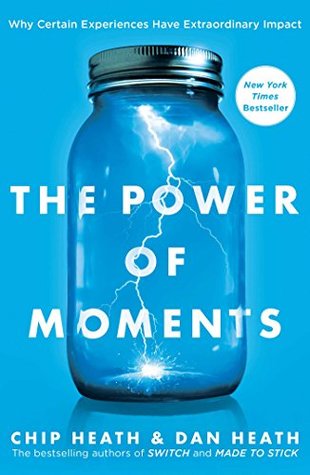More on this book
Community
Kindle Notes & Highlights
by
Chip Heath
Read between
May 9, 2022 - October 19, 2024
When people assess an experience, they tend to forget or ignore its length—a phenomenon called “duration neglect.”
they seem to rate the experience based on two key moments: (1) the best or worst moment, known as the “peak”; and (2) the ending.
remember flagship moments: the peaks, the pits, and the transitions.
ELEVATION: Defining moments rise above the everyday. They provoke not just transient happiness, like laughing at a friend’s joke, but memorable delight.
INSIGHT: Defining moments rewire our understanding of ourselves or the world.
PRIDE: Defining moments capture us at our best—moments of achievement, moments of courage.
CONNECTION: Defining moments are social: weddings, graduations, baptisms,
These moments are strengthened because we share them with others.
Defining moments possess at least one of the four elements above, but they need not have all four.
What we’re doing on New Year’s Day is more like a mental accounting trick. Our past failures are left on the ledger of Old Me. New Me starts today. New Year’s resolutions should really be called New Year’s absolutions.
Pits need to be filled.
Emory University surveyed 3,000 people about their weddings, they found that more expensive weddings were correlated with a higher chance of divorce.
6 out of the 10 most important events all happen during a relatively narrow window of time: roughly age 15 to 30.
“reminiscence bump.”
once every 5 to 10 meetings, find a way to break the script.
psychologist Roy Baumeister has studied these kinds of sudden realizations:
“crystallization of discontent,”
You can’t appreciate the solution until you appreciate the problem.
“The dirty secret of higher education is that faculty aren’t taught how to teach,”
A “six sigma” process is one that produces only 3.4 defects per million attempts.
“What did you guys fail at this week?”
when you seek out situations where you might fail, failure loses some of its menace. You’ve been inoculated against it.
“More than 80 per cent of supervisors claim they frequently express appreciation to their subordinates, while less than 20 per cent of the employees report that their supervisors express appreciation more than occasionally.” Call it the recognition gap.
When we talk about the need to recognize employees, we’re not aiming for one employee per month! The proper pace of recognition is weekly or even daily, not monthly or yearly.
DonorsChoose’s website allows teachers to seek crowdsourced funding for school projects.
To experience more defining moments, we need to rethink the way we set goals.
Conquering each level feels good. It feels so good, in fact, that you can love playing a game even if you never finish it.
instinct to notice and commemorate achievements is oddly lacking in many areas of life.
A wise leader can look for milestones en route to a larger goal.
What’s inherently motivating?
What would be worth celebrating that might only take a few weeks or months of work?
What’s a hidden accomplishment that is worth surfacin...
This highlight has been truncated due to consecutive passage length restrictions.
researcher George Wu at the University of Chicago.
the most common trait you will consistently observe in accomplished people is an obsession with completion. Once a project falls into their horizon, they crave almost compulsively, to finish
When the police arrived to respond to the violence, 77 black students were arrested for loitering and disorderly conduct. None of the hostile whites were arrested.
the parents of the students, horrified that their children had been jailed, rallied the black community around a new idea: a boycott of the segregated downtown stores. “Let’s stop supporting the system we’re trying to change,”
April 19, a bomb was thrown into the home of Z. Alexander Looby, the lawyer for the black students.
James Lawson. Lawson, a Methodist minister, had traveled to India to learn the techniques of nonviolent resistance from the disciples of Mahatma Gandhi.
psychologist S. J. Rachman wrote in a report on military training,
exposure therapy,
Jayson Mystkowski, the researchers applied exposure therapy to people terrified of spiders.
level-up plan,
mental rehearsals.
psychologist Peter Gollwitzer
research shows that when people make advance mental commitments—if X happens, then I will do Y—they are substantially more likely to act in support of their goals
“implementation intentions,”
the situations that lead to unethical behavior are predictable: A relentless pressure for results, coupled with avert-the-eyes management, will lead to cut corners or outright fraud (think banking scandals). Blurry lines of accountability, plus get-things-done urgency, will lead to accidents
everyone will face an anxiety-making conversation.
Every industry has its own unique set of emotional encounters:


